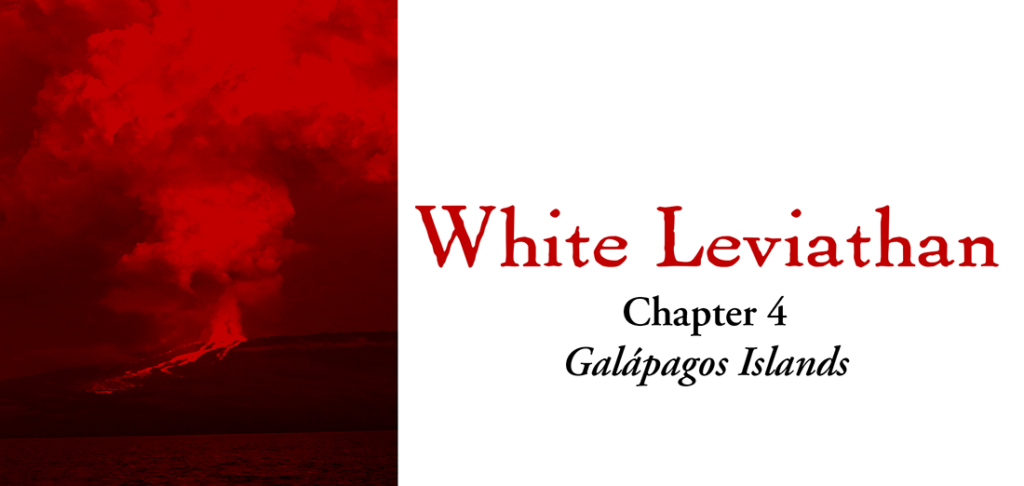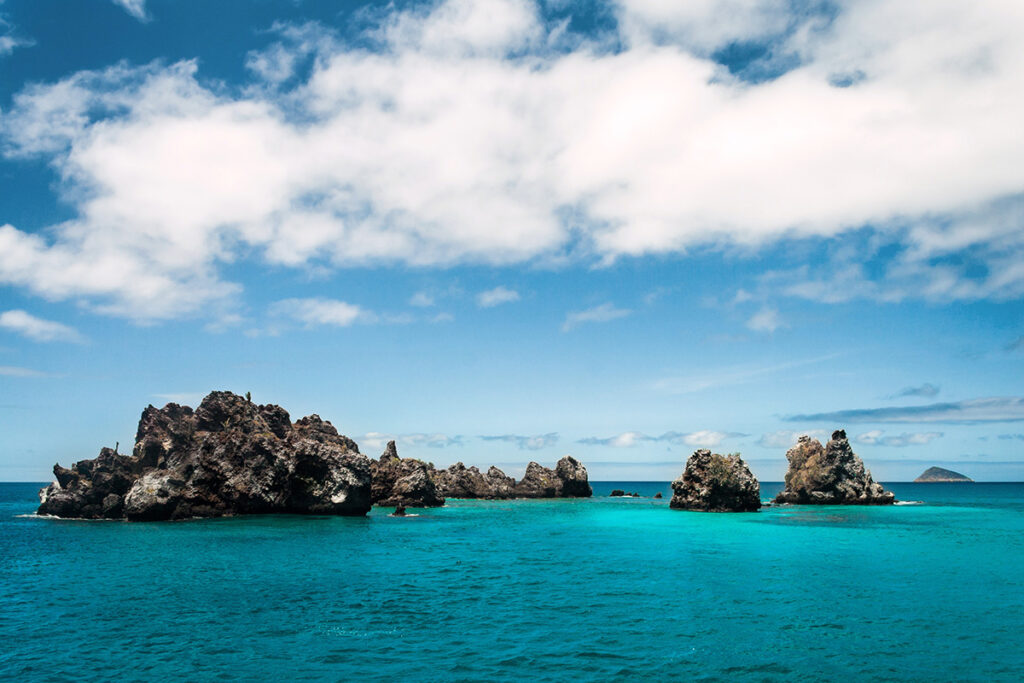Galápagos Islands: Charles Island
- At October 31, 2022
- By Great Quail
- In White Leviathan
 0
0
3) Charles Island (Isla Floreana)
Galápagos Islands, June 18-23, 1845
Charles Island (Shutterstock)
A) Paradise Lost
Located in the mid-south end of the chain between Hood Island and Albemarle Island, Charles Island is an active volcano surrounded by stunningly clear water. Its shallow coastal platforms are populated by hammerhead sharks and manta rays, which may be seen skating through the crystalline water above the white sands. The beaches range from pure white to olivine green, with all manner of exotic shells sparkling in the tide. The island is the most verdant in the chain, and its central valley contains numerous fresh-water springs. There’s also an abundance of ducks, petrels, Galápagos penguins, blue-footed boobies, finches, and colorful flamingos.
The Essex Fire
In 1820 the whalemen from the infamous Essex started a fire on Charles Island, triggering a conflagration that nearly desolated the entire ecosystem. Some twenty-five years later the island is still recovering, with scorched rocks and patches of burned trees offering evidence of their carelessness. Worse, the blaze decimated the tortoise population, a black-colored variety widely considered the tastiest in the Galápagos. By 1845 the creatures have become rare; in a few more years the subspecies will become extinct.
B) Human Society
Of all the islands in the archipelago, Charles Island is most hospitable to life, and has hosted numerous hermits and “castaway republics.” Sailors still talk about the Irish mutineer Pat “Oberlus” Watkins, “Johnston” the vengeful Swede, and the wild dogs imported by Peru to slaughter the buccaneer’s goats. Currently, the island’s most famous resident is General José Villamil, the “Creole Dog King” in charge of Asilo de la Paz, an Ecuadorian penal colony located in the central highlands. The presence of this colony has given traction to the Ecuadorian name of the island, Isla Floreana, usually rendered in English as “Floriana Island.”
C) Post Office Bay (June 18)
The Quiddity approaches Charles Island from the northeast, skirting the tiny Enderby Island and passing around Devil’s Crown, the protruding remnants of a volcanic crater now transformed into a reef system.
Devil’s Crown (Shutterstock)
Two miles away from Devils Crown is “Post Office Bay,” an informal mail drop used by American and British whalers. The Quiddity drifts into the bay, then backs its sails and heaves to. Joab instructs Mr. Coffin to select a boat crew and bring the mailbag. Joab himself accompanies the boat, departing with Mr. Coffin at the shore as the crew remains behind.
The “post office” is a hundred yards from shore, accessible through a pathway winding through the saltbush. Little more than a sealed barrel atop a wooden pole, the mail drop is protected from the elements by the shell of a 400-pound tortoise. Letters are placed in the barrel, and homebound ships pick them up for eventual delivery. The tradition was started in 1793 by Captain James Colnett, and attentive captains replace the barrel whenever the elements have taken their toll. The barrel is surrounded by several wry signs, mostly guideposts proclaiming the distance and direction to ports such as New Bedford, Nantucket, and London. These reminders of home are bolstered by a few more whimsical additions: Prester John’s Kingdom, Tir na nog, and the “Nearest Mermaid’s Whorehouse” are the current crop.
Joab opens the barrel and sorts through the mail eagerly. Upon finding a letter marked “CAPTAIN JOB, mstr. QUIDDITY,” he snatches it up and reads it aloud. (Handout: Letter from Tripp to Joab.) With a wild, scornful laugh, he tosses the letter to the ground and scoffs, “This fellow claims to have killed my nemesis himself? Oh has he? I think not! Ha ha ha!” As he stomps away, he suddenly wheels around on his peg—“Mr. Coffin, prithee, do me the favor of retrieving good Master Tripp’s letter. We shall indeed stop at Banks Cove and have a word with this Tarnmoor fellow.” A Psychology roll suggests that Joab is genuinely more amused than alarmed—it’s clear he does not believe the story.
D) The Grave
As Coffin bends to retrieve the letter, the Keeper should call for a Spot Hidden roll. A success spies something interesting a few dozen yards past the saltbush: grave markers. (The Keeper may grant sight of the markers even if Coffin fails the roll.) If Coffin investigates the site, he finds a makeshift graveyard supporting four wooden markers surrounded by black, volcanic rocks. The dates stretch back twenty years, and all the names are accompanied by a ship. The most recent marker draws Coffin’s immediate attention:
CAPT. LUKE COFFIN
Of the CHRISTABEL
Died 11th November 1839
God rest his soul
Mr. Coffin’s reaction is entirely up to the player, and the Keeper should respond accordingly. If he’s distraught, a 1/1D4 Sanity roll may be in order; but if he finds some kind of closure, the Keeper may restore 1D4 Sanity points. If Joab is alerted to this development, he becomes immediately sympathetic, even offering to pray over the gravesite. He’ll grant Coffin a day of relieved duties—“It’s all right, man. This would luff the sails of any stout ship. Take some time and get thine mental compass straight.” If—for whatever inconceivable reason!—Captain Coffin’s grave is exhumed, his moldering corpse is revealed, wrapped in sailcloth and clutching a daguerreotype of his wife, Philomena. There are no signs of foul play.
E) Turpining: Charles Island Edition (June 19-23)
Hungry for the sweet terrapins of Charles Island, Joab rounds the island to Black Beach. A volcanic bay located on the west side of the island, Black Beach offers access to Floreana’s fertile interior. Joab orders Mr. Dixon to lead an expedition to see if any tortoises can be “roused from this former paradise.” He’s instructed to bring six crewmen and a musket—“These mulattos are usually decent folk, but this is a penal colony. One can’t be too careful.” The expedition takes a few days, with the sailors ranging back and forth from the ship. Each hunter is allowed one Luck roll; a success bags a tortoise and earns the captain’s approval. The group may also shoot a reasonable number of fowl, mostly wild ducks.
Meanwhile, Whipple’s men are dispatched to the highland springs to obtain fresh water. Because there’s no river large enough for whaleboats, and the Quiddity has no pack mules, they’re instructed to take a leather hose and use bamboo chutes to channel water to the beach. It’s pure grunt-work, an obvious punishment for their “desertion” at Atacames, and Whipple’s entire crew knows it. Henry Swain’s grousing speaks for all—“Aye, turpining ain’t much fun, but we’d get to see the island, shoot some ducks. This? We already have enough fresh water, this is horse shit!”
White Leviathan, Chapter 4—Galápagos Islands
[Back to Encounter 2, Hood Island | White Leviathan TOC | Forward to Encounter 4, Asilo de la Paz]
Author: A. Buell Ruch
Last Modified: 14 August 2023
Email: quail (at) shipwrecklibrary (dot) com
White Leviathan PDF: [TBD]



